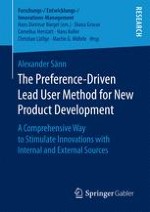Alexander Sänn presents a functional method based on lead user method, preference measurement, and recommendations using collaborative filtering. The introduced method in this book stimulates input from internal and external sources, predicts basic customers’ acceptance, and evaluates this input against pre-defined criteria such as feasibility and existing patents for further concept generation. In sum, the new method addresses common innovation barriers and helps to reduce management uncertainties. This book provides further insights to the use of lead users as innovation sources in three major industries. The author extends the methodological toolbox with practical implications and contributes to the highly discussed topic in innovation management.
